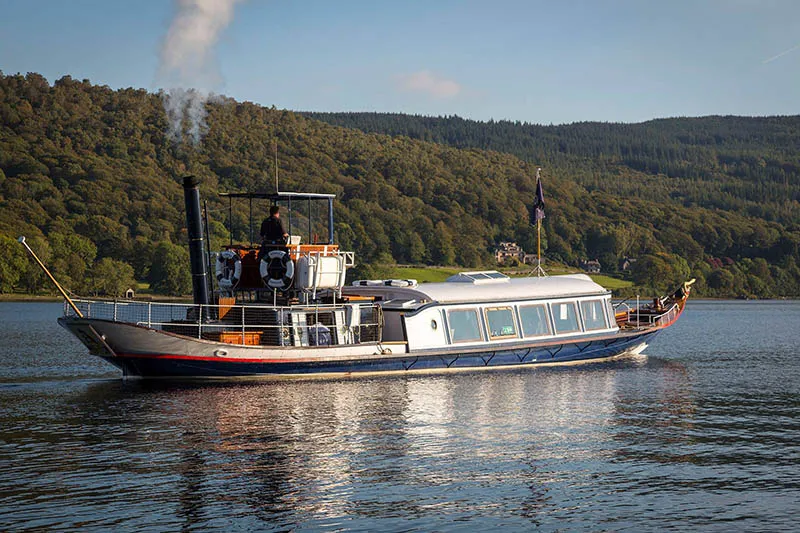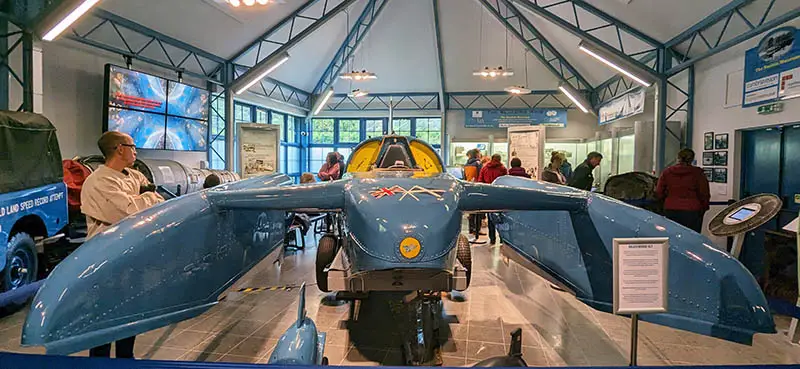Coniston Water
Coniston Water, the fifth-largest lake in the Lake District, is five miles in length and reaches depths of up to 184 feet. Set amid some of the Lake District’s most iconic scenery, Coniston Water is a hub for outdoor enthusiasts and those seeking tranquility. The pretty village of Coniston is just a short walk from the lake. However, despite being only eight miles from the bustling town of Ambleside, Coniston Water remains far less commercialised than nearby Windermere lake. This is likely due to the very narrow, winding lanes leading from Ambleside to Coniston.

Photo by Dave Brown
Afloat on Coniston Water
Visitors can explore the lake with a variety of boating options available at the Coniston Boating Centre. Rowing boats, motorboats, kayaks, canoes, and paddleboards are available to hire, as well as a range of bikes.
Bank Ground Farm, on the northern shore of Coniston Water, also offers boat, SUP and canoe hire. Electric car charging is also available here by arrangement. More information about Bank Ground farm is further down the page.
For a more leisurely experience, the Steam Yacht Gondola, a beautifully restored Victorian vessel operated by the National Trust, offers cruises between March and November. The Gondola includes stops at key locations such as Brantwood, the historic home of John Ruskin, and provides a luxurious way to take in the lake’s beauty. (More about the Steam Yacht Gondola here)
Meanwhile, the smaller, traditional vessels of Coniston Launch run regular services, connecting jetties around the lake. (More about Coniston Launch here)
The Steam Yacht Gondola on Coniston Water

Refreshment stops around the lake
The Bluebird Café, located close to the Coniston Boat Landings, is easily accessible from both the Coniston Launch and Steam Yacht Gondola, with the jetty just a short walk away. This café offers a selection of light lunches, snacks, and drinks in a scenic lakeside location.
At the northern end of Coniston Water, Bank Ground Farm‘s ‘Swallows and Amazons Cafe’ is a popular stop for breakfasts, lunch and afternoon tea. The farm also offers accommodation, and the website link can be found at the foot of this page.
On the eastern shore, the Terrace Coffee House and Restaurant at Brantwood is another must-visit destination. Known for its homemade dishes and breathtaking views across the water, it provides a serene spot for dining or enjoying a coffee.
Both boat services make regular or request stops at the Brantwood jetty, allowing visitors to explore the café, Ruskin’s historic home, and the beautifully maintained gardens surrounding it. These dining options make for convenient and enjoyable breaks during a day of discovery. (More about Brantwood here)
Coniston Water seen through the windows at Brantwood

As well as the above, Coniston Village offers a wide range of excellent inns, cafes, and bakeries. The village is just over half a mile from the main boat landings, where Coniston Boating Centre and the Steam Yacht Gondola are located.
Parking near Coniston Water
Parking is quite readily available. The Monk Coniston Car Park at the northern end of the lake is a useful starting point for walks or for launching small, non-powered craft. The Coniston Boating Centre Car Park, near the Bluebird Café, offers easy access to the water and pay-on-exit facilities. Additionally, the Ruskin Avenue Car Park in Coniston village provides a convenient option for those visiting local shops or dining establishments, with the lake a short walk away.
Watercourses
Coniston Water is fed by several streams, including Yewdale Beck, which flows into its northern end, and Torver Beck, which enters from the west near Torver village. Water exits the lake at its southern tip through the River Crake. This in turn winds its way toward Morecambe Bay, sustaining local ecosystems along its course.
Coniston Water Islands
Peel Island
Peel island is famously linked to Arthur Ransome’s classic children’s novel, Swallows and Amazons: it is thought to have inspired “Wild Cat Island. It is popular with kayakers and canoeists who enjoy its small beach and tranquil surroundings. Although private, its natural beauty makes it a well-loved feature of the lake. (More about Swallows and Amazons here)
Fir Island
Fir Island, the smallest of the three, is a more secluded and peaceful spot. Situated near the northern end of Coniston Water, it is covered with dense vegetation, providing a quiet refuge for local wildlife. Its inaccessibility make it less visited, allowing it to remain largely undisturbed.
Oak Island
Oak Island, positioned toward the southern end of the lake, is slightly larger than Fir Island but smaller than Peel Island. Like the others, it is cloaked in trees and greenery. While not as prominent in literary or historical references as Peel Island, it is still a charming feature of Coniston Water.

Wildlife around Coniston Water
Birds
Coniston Water and its surrounding habitats support a rich variety of wildlife. The woodlands and high places around the lake are home to many breeding populations of birds. Species include redstarts and ring ouzels during the nesting season, while raptors such as buzzards and peregrine falcons reflect the area’s healthy ecosystems. A diverse range of waterfowl, including tufted ducks, goldeneyes, cormorants and merganser use the lake, particularly during migration periods. An external link at the foot of this page gives a list of bird sightings on and near Coniston Water.
Red Squirrels
Red squirrels (Sciurus vulgaris) remain a key species in the region, particularly in nearby Grizedale Forest, despite competition from non-native grey squirrels (Sciurus carolinensis). Conservation initiatives, led by those such as Westmorland Red Squirrels, focus on habitat management and controlling grey squirrel populations to protect the red squirrel’s long-term survival. Broader conservation efforts led by the National Trust aim to sustain the biodiversity of the lake and surrounding woodlands, benefiting species like the otter and ensuring the lake remains a haven for wildlife.
Red squirrels (Sciurus vulgaris). Credit Jonny Gios

Otters
Otters (Lutra lutra) inhabit areas around Coniston Water and its feeder streams. These shy mammals thrive in clean waterways with abundant food sources. While sightings are rare due to their elusive nature, evidence of their presence has been observed. The National Trust highlights that along the path leading from the northern end of Coniston Water toward Tarn Hows, visitors might encounter wildlife such as otters, red squirrels, and hares.
How Clean is Coniston Water?
In 2024 EA results, Monk Coniston was classified as excellent. Brown How was classified as good. The bathing water area near the STW, near Coniston Village, was however classified as poor. Coniston Parish Council is pressing for investment and improvement in performance at United Utilities STW. See also Windermere lake page for information on the Save Windermere campaign.
A Colourful History
Medieval Monks
Furness Abbey, founded in 1127, owned much of the land around Coniston Water during the medieval period, relying on the lake as a vital resource. The abbey’s monks fished for char and trout to support their diet and managed surrounding woodlands and farmlands to sustain their economy. These activities contributed to the abbey’s wealth and influence, with Coniston Water playing a key role in its self-sufficiency until the dissolution of monasteries in the 16th century. (More about Furness Abbey here)
Industrial Revolution
In the 19th century, Coniston Water played a vital role in supporting local industry by serving as a transport route for slate and copper ore extracted from the nearby Coppermines Valley. This valley, located above Coniston village, was a hub of mining activity, producing valuable copper and slate that were in high demand during the Industrial Revolution. The extracted materials were transported via horse-drawn carts to the shores of Coniston Water, where they were loaded onto barges. These barges carried the goods down the lake to the southern end, near the River Crake, which provided further connections to larger transport networks. This use of the lake as a natural highway reduced the challenges of navigating the region’s rugged terrain and contributed to the growth of Coniston as an thriving village.
Coniston Water Tragedy
In the 20th century, Coniston Water gained fame for its association with water speed records. In 1939, Sir Malcolm Campbell set a record here, achieving speeds of over 141 miles per hour. His son, Donald Campbell, continued the legacy, piloting the Bluebird K7 to incredible speeds. Tragically, Donald lost his life in 1967 while attempting to surpass 300 miles per hour. A memorial to Donald Campbell can be found near the information center in Coniston village. The jet-powered hydroplane Bluebird K7, piloted by Campbell, was retrieved from the bottom of Coniston Water in 2001 and has now been fully restored. Bluebird K7 is now housed in Coniston village, showcased in a specially designed section of the Ruskin Museum. (Read more here)
Bluebird K7 in the Ruskin Museum

Coniston Water is also linked to the infamous “Lady in the Lake” case. In 1976, Carol Park disappeared, and her body was found submerged in the lake in 1997. The discovery led to the conviction of her husband, Gordon Park, in 2005. This case, widely covered in the media, remains a sad part of the lake’s modern history.
Other pages of interest:
- Coniston Village
- Coniston Launch
- Steam Yacht Gondola
- Lake District National Park
- John Ruskin
- Brantwood
- Ruskin Museum
- Grizedale Forest
- South Lakes Area Menu
- Lakes and Tarns
External links relating to Coniston Water
- The Coppermines Lakes Cottages – Holiday Cottage Agency based in Coniston village
- Coniston Boating Centre
- Bank Ground Farm
- Westmorland Red Squirrels
- eBird Field Checklist Coniston Water
Grid Ref : SD 305950
Planning a visit to beautiful Coniston Water? Enter your dates below to compare available accommodation on a handy map.
